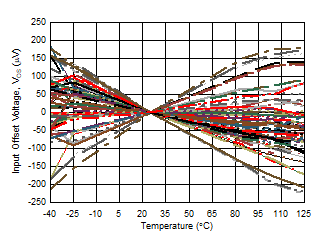at TA ≈ 25°C,
VOCM pin = open, RF = 1.5 kΩ, RL = 1 kΩ, VO = 2
VPP, 50-Ω input match, G = 1 V/V, PD =
VS+, single-ended input, differential output, and input and output
referenced to default midsupply for AC-coupled tests (unless otherwise noted); see
Figure 8-1 for a gain of 1-V/V test circuit.

| 1000
DGK units at each VS |
Figure 7-35 Input
Offset Voltage (VOS)
VS = 12 V, 5 V, and 3 V,
delta from 25°C
VOS, 30 DGK units for each
VS |
Figure 7-37 Input
Offset Voltage vs Temperature
| –40°C to +125°C endpoint drift, 30 DGK units for each
VS |
Figure 7-39 Input
Offset Voltage Drift Histogram Figure 7-41 Main
Amplifier Differential Open-Loop Gain and Phase vs Frequency
Figure 7-41 Main
Amplifier Differential Open-Loop Gain and Phase vs Frequency Figure 7-43 Closed-Loop Output Impedance vs Frequency
Figure 7-43 Closed-Loop Output Impedance vs Frequency Figure 7-45 Quiescent Current vs VS
Figure 7-45 Quiescent Current vs VS Figure 7-47 Common-Mode Voltage, Small-Signal and Large-Signal Response (VOCM Pin
Driven)
Figure 7-47 Common-Mode Voltage, Small-Signal and Large-Signal Response (VOCM Pin
Driven)
| VOCM
pin driven, 0.1-V VOCM step |
Figure 7-49 Common-Mode Voltage Small-Signal Step Response Figure 7-51 Output Balance vs Frequency
Figure 7-51 Output Balance vs Frequency
| 1000
DGK units at each VS |
Figure 7-36 Input
Offset Current (IOS)
VS = 12 V and 5 V,
delta from 25°C
IOS, 50 DGK units for each
VS |
Figure 7-38 Input
Offset Current vs Temperature
| –40°C to +125°C endpoint drift, 50 DGK units for each
VS |
Figure 7-40 Input
Offset Current Drift Histogram Figure 7-42 Open-Loop Output Impedance vs Frequency
Figure 7-42 Open-Loop Output Impedance vs Frequency
| VO = 100-mV step, tr (10% -
90%) = 5.7 ns |
Figure 7-44 Small-Signal Step Response Figure 7-46 PD Turnon and Turnoff Waveform
Figure 7-46 PD Turnon and Turnoff Waveform
| The
VOCM pin is either driven to midsupply by low-impedance
source or allowed to float and default to
midsupply |
Figure 7-48 Output Common-Mode (VOCM) Noise vs Frequency
| VOCM
pin driven, 1-V VOCM step |
Figure 7-50 Common-Mode Voltage Large-Signal Step Response Figure 7-52 CMRR
and PSRR vs Frequency
Figure 7-52 CMRR
and PSRR vs Frequency
















